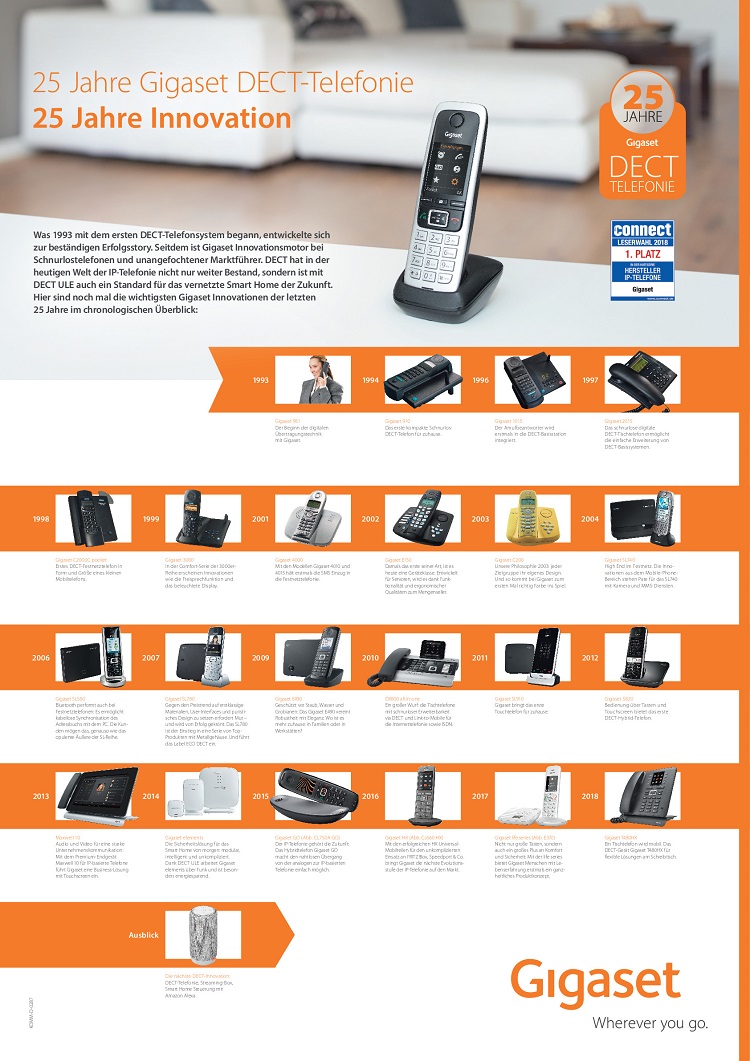 Source: iStock.com/mattjeacock
Source: iStock.com/mattjeacock
It opened up a whole new world: 25 years of DECT
27. November 2018 Published by Raphael DoerrThere are moments that change everything. The one we’re talking about isn’t perhaps on a par with the first man on the moon or the discovery of the theory of relativity. Yet it was nevertheless a revolution 25 years ago. And our engineers realized right way that it was a moment that would change everything. Well, maybe not everything. We’re taking about the launch of the DECT standard. The existing analog wireless connections between the base station and handset of cordless phones were replaced by “Digital Enhanced Cordless Telecommunications.” No more background noise, no more losses of connection. That immediately opened up a whole new world in our developers’ minds. Even back then, they had an idea of all the things that would be made possible thanks to DECT. Digitalization had finally reached fixed-line telephony. And we were one of the pioneers.
Gigaset launched its first DECT telephone system in 1993. And it marked the beginning of an enduring success story. Our company emerged as a driver for innovation in cordless telephones and has been the undisputed market leader in Europe for decades.
Bye-bye, cassette!
Inspired by the possibilities DECT offered, our engineers unleashed their creativity in the subsequent years: As early as 1996, the Gigaset 1015 had an integrated digital answering machine – external devices with cassette drives had been customary up to then. The Gigaset 3000 arrived in 1999, featuring a loudspeaker function and illuminated display. Much smaller models such as the C2000C pocket and the first large-key telephone Gigaset E150 met the needs of different age groups.
In the 2000s, Gigaset brought features from mobile telephony to cordless fixed network telephones for the first time: Phones from the Gigaset 4000 series could send and receive SMS texts, the SL740 had a camera and offered MMS services, and the SL560 could be linked to headsets via Bluetooth. In 2011, Gigaset SL910 became the first touch telephone for the home. The latest addition to the family is the desktop phone T480HX. The device, with multiple business functions, connects like a handset to the existing base station via DECT, allowing users to even spontaneously move the home office out to the patio.

Zero radiation thanks to ECO DECT
Gigaset has always kept up with the times when it comes to its fixed network telephones. New ideas were thought through down to the last detail in order to give users real added value. As the health consciousness of people grew following the turn of the millennium, the issue of radiation exposure at home was called into question. Gigaset took the concerns of its customers seriously and introduced ECO DECT. Devices that carry this label are particularly low radiation and use 60 percent less energy. Variable functions reduce the transmission power when it’s not needed. A short time later came the ECO Modus Plus, which allowed telephones to operate radiation-free in standby mode. It was based on a new technology that enabled rapid synchronization of the base and handset with incoming or outgoing calls. During calls, the ECO mode reduces transmission power by 80 percent. All Gigaset telephones have carried the ECO DECT label for more than ten years.
DECT goes ULE
The decades of experience with DECT also played a key role in developing the Gigaset Smart Home alarm system. Gigaset wanted to build small cordless sensors for its customers that were easy to attach to doors or windows – without any installation or tangled cables. The solution was the DECT ULE standard. ULE stands for Ultra Low Energy, which gives the battery-powered sensors a very long lifespan without having to change batteries.
In the last 25 years, Gigaset has shaped and continuously developed the DECT standard like no other company. And next year Gigaset is also planning further innovative products that might not have been possible without DECT.
 Comments
Comments

 en
en 







